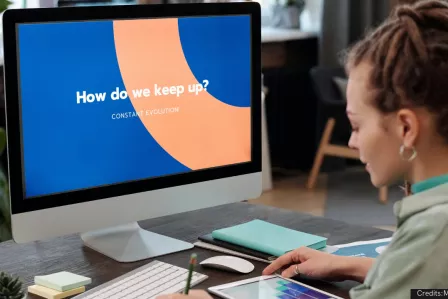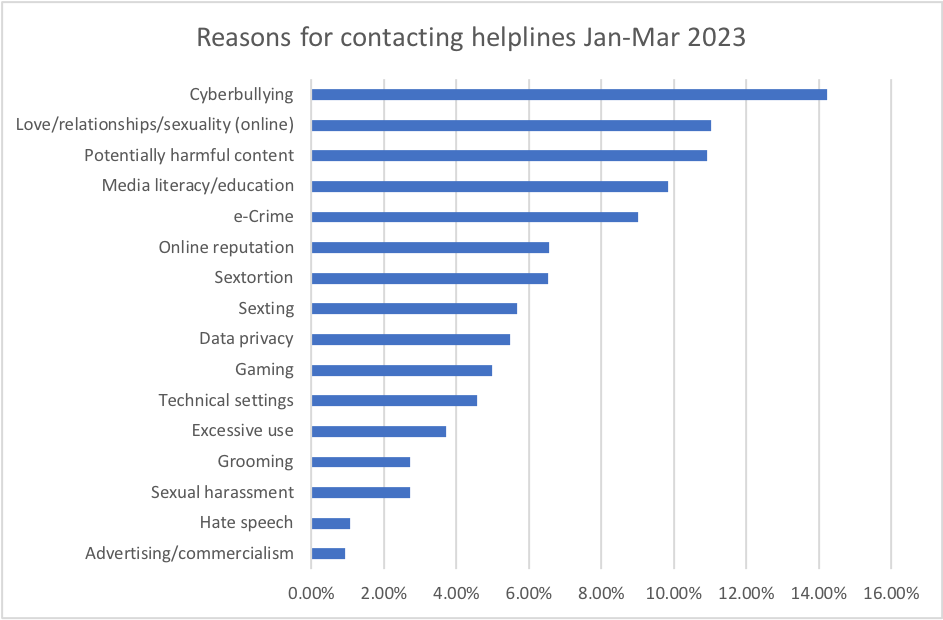The Insafe network of helplines collects data about the types of calls they receive and this is analysed every three months in order to look at possible trends and emerging issues.

The most recent helpline data covers the period from January to March 2023. There were over 19,500 contacts made to the network which once again shows a steady increase in numbers since the previous reporting period. There has been an overall upward trend in numbers using the helplines over the last three to four years.
Teenagers are the largest group who are making use of helpline services with 52 per cent of contacts received from 12-18-year-olds during this period. There was a significant increase in the number of teachers reaching out to helplines (17.3 per cent), although it is difficult to determine exactly why this is.
Despite the developments in chat technologies and other online means of contacting a helpline, contact by phone remains the most popular method of getting in touch with around 50 per cent of contacts being made this way.
Cyberbullying continues to be the most common reason for contacting a helpline, accounting for 14 per cent of all contacts: a fall of two percentage points since the previous quarter. Love, relationships and sexuality (online) both received 11 per cent of contacts, and issues related to sexual harassment, sexting and sextortion represented around 15 per cent which reinforces the challenges that young people continue to have in this area.
Several helplines once again reported growing numbers of reports relating to sextortion and there is a global rise in these cases at present, mainly targeting teenage boys.
Helplines continue to strive to offer the best possible services to their users. The French helpline has recently increased its hours of operation by an additional 34 hours per week, while the Dutch helpline has expanded the issues that it is able to offer support with. The Dutch helpline was previously called the Expert Centre for Online Child Abuse (EOKM) but has now been renamed Offlimits” – the Expert Centre for Online Harm and Abuse. The role of EOKM was quite specific and this change in focus means that the helpline is now able to provide support for a wider range of issues including cyber-stalking, doxing, hacking and cyberbullying, recognising the broad range of challenges that young people are facing online.

Figure 1: Reasons for contacting helplines January-February 2023 (Better Internet for Kids)
| Reason for contacting helplines | Percentage of contacts |
| Hate speech | 1 per cent |
| Advertising/commercialism | 1 per cent |
| Grooming | 3 per cent |
| Sexual harassment | 3 per cent |
| Excessive use | 4 per cent |
| Technical setting | 5 per cent |
| Data privacy | 5 per cent |
| Gaming | 5 per cent |
| Sexting | 6 per cent |
| Online reputation | 7 per cent |
| Sextortion | 7 per cent |
| e-Crime | 9 per cent |
| Media literacy/education | 10 per cent |
| Potentially harmful content | 11 per cent |
| Love/relationship/sexuality(online) | 11 per cent |
| Cyberbullying | 14 per cent |
Find out more about country-based helpline services, operating as part of the national Safer Internet Centre, at www.betterinternetforkids.eu/sic. Find news updates on helpline services and challenges at www.betterinternetforkids.eu/practice/helplines.
The Insafe network of helplines collects data about the types of calls they receive and this is analysed every three months in order to look at possible trends and emerging issues.

The most recent helpline data covers the period from January to March 2023. There were over 19,500 contacts made to the network which once again shows a steady increase in numbers since the previous reporting period. There has been an overall upward trend in numbers using the helplines over the last three to four years.
Teenagers are the largest group who are making use of helpline services with 52 per cent of contacts received from 12-18-year-olds during this period. There was a significant increase in the number of teachers reaching out to helplines (17.3 per cent), although it is difficult to determine exactly why this is.
Despite the developments in chat technologies and other online means of contacting a helpline, contact by phone remains the most popular method of getting in touch with around 50 per cent of contacts being made this way.
Cyberbullying continues to be the most common reason for contacting a helpline, accounting for 14 per cent of all contacts: a fall of two percentage points since the previous quarter. Love, relationships and sexuality (online) both received 11 per cent of contacts, and issues related to sexual harassment, sexting and sextortion represented around 15 per cent which reinforces the challenges that young people continue to have in this area.
Several helplines once again reported growing numbers of reports relating to sextortion and there is a global rise in these cases at present, mainly targeting teenage boys.
Helplines continue to strive to offer the best possible services to their users. The French helpline has recently increased its hours of operation by an additional 34 hours per week, while the Dutch helpline has expanded the issues that it is able to offer support with. The Dutch helpline was previously called the Expert Centre for Online Child Abuse (EOKM) but has now been renamed Offlimits” – the Expert Centre for Online Harm and Abuse. The role of EOKM was quite specific and this change in focus means that the helpline is now able to provide support for a wider range of issues including cyber-stalking, doxing, hacking and cyberbullying, recognising the broad range of challenges that young people are facing online.

Figure 1: Reasons for contacting helplines January-February 2023 (Better Internet for Kids)
| Reason for contacting helplines | Percentage of contacts |
| Hate speech | 1 per cent |
| Advertising/commercialism | 1 per cent |
| Grooming | 3 per cent |
| Sexual harassment | 3 per cent |
| Excessive use | 4 per cent |
| Technical setting | 5 per cent |
| Data privacy | 5 per cent |
| Gaming | 5 per cent |
| Sexting | 6 per cent |
| Online reputation | 7 per cent |
| Sextortion | 7 per cent |
| e-Crime | 9 per cent |
| Media literacy/education | 10 per cent |
| Potentially harmful content | 11 per cent |
| Love/relationship/sexuality(online) | 11 per cent |
| Cyberbullying | 14 per cent |
Find out more about country-based helpline services, operating as part of the national Safer Internet Centre, at www.betterinternetforkids.eu/sic. Find news updates on helpline services and challenges at www.betterinternetforkids.eu/practice/helplines.
- < Previous article
- Next article >












